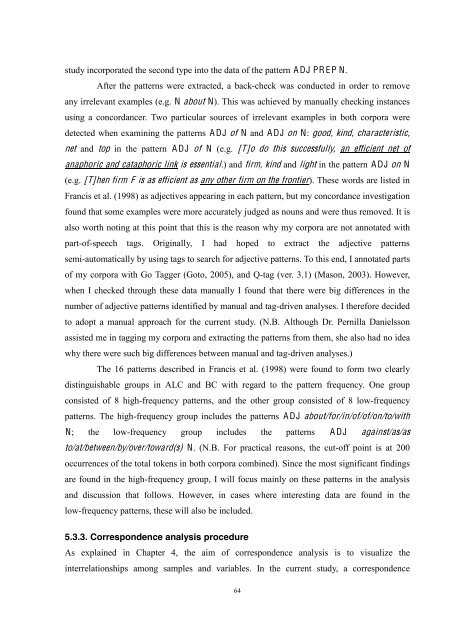Evaluative Meanings and Disciplinary Values - eTheses Repository ...
Evaluative Meanings and Disciplinary Values - eTheses Repository ...
Evaluative Meanings and Disciplinary Values - eTheses Repository ...
Create successful ePaper yourself
Turn your PDF publications into a flip-book with our unique Google optimized e-Paper software.
study incorporated the second type into the data of the pattern A DJ PR EP N.<br />
After the patterns were extracted, a back-check was conducted in order to remove<br />
any irrelevant examples (e.g. N about N). This was achieved by manually checking instances<br />
using a concordancer. Two particular sources of irrelevant examples in both corpora were<br />
detected when examining the patterns A DJ of N <strong>and</strong> A DJ on N: good, kind, characteristic,<br />
net <strong>and</strong> top in the pattern A DJ of N (e.g. [T]o do this successfully, an efficient net of<br />
anaphoric <strong>and</strong> cataphoric link is essential.) <strong>and</strong> firm, kind <strong>and</strong> light in the pattern A DJ on N<br />
(e.g. [T]hen firm F is as efficient as any other firm on the frontier). These words are listed in<br />
Francis et al. (1998) as adjectives appearing in each pattern, but my concordance investigation<br />
found that some examples were more accurately judged as nouns <strong>and</strong> were thus removed. It is<br />
also worth noting at this point that this is the reason why my corpora are not annotated with<br />
part-of-speech tags. Originally, I had hoped to extract the adjective patterns<br />
semi-automatically by using tags to search for adjective patterns. To this end, I annotated parts<br />
of my corpora with Go Tagger (Goto, 2005), <strong>and</strong> Q-tag (ver. 3.1) (Mason, 2003). However,<br />
when I checked through these data manually I found that there were big differences in the<br />
number of adjective patterns identified by manual <strong>and</strong> tag-driven analyses. I therefore decided<br />
to adopt a manual approach for the current study. (N.B. Although Dr. Pernilla Danielsson<br />
assisted me in tagging my corpora <strong>and</strong> extracting the patterns from them, she also had no idea<br />
why there were such big differences between manual <strong>and</strong> tag-driven analyses.)<br />
The 16 patterns described in Francis et al. (1998) were found to form two clearly<br />
distinguishable groups in ALC <strong>and</strong> BC with regard to the pattern frequency. One group<br />
consisted of 8 high-frequency patterns, <strong>and</strong> the other group consisted of 8 low-frequency<br />
patterns. The high-frequency group includes the patterns A DJ about/for/in/of/of/on/to/with<br />
N; the low-frequency group includes the patterns A DJ against/as/as<br />
to/at/between/by/over/toward(s) N. (N.B. For practical reasons, the cut-off point is at 200<br />
occurrences of the total tokens in both corpora combined). Since the most significant findings<br />
are found in the high-frequency group, I will focus mainly on these patterns in the analysis<br />
<strong>and</strong> discussion that follows. However, in cases where interesting data are found in the<br />
low-frequency patterns, these will also be included.<br />
5.3.3. Correspondence analysis procedure<br />
As explained in Chapter 4, the aim of correspondence analysis is to visualize the<br />
interrelationships among samples <strong>and</strong> variables. In the current study, a correspondence<br />
64
















